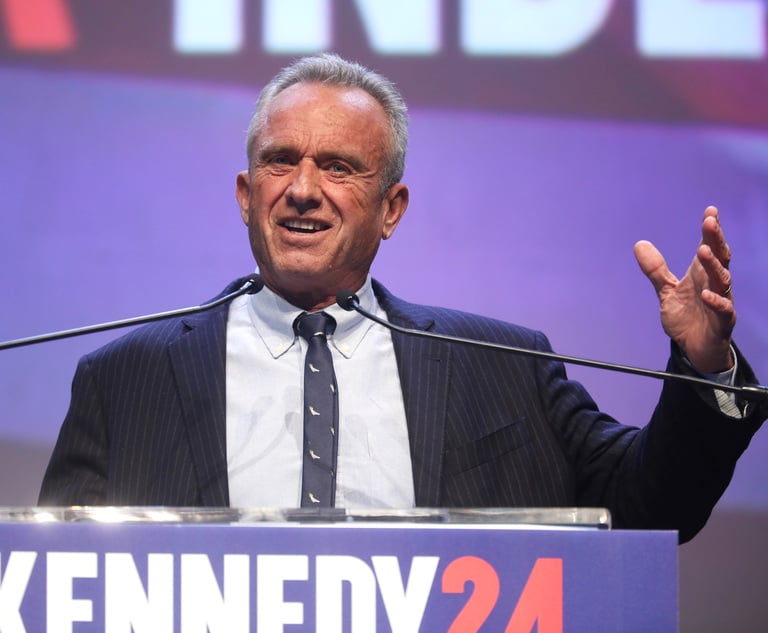 Federal Reserve Board Chair Jerome Powell. Photo: Patrick Semansky/AP, File
Federal Reserve Board Chair Jerome Powell. Photo: Patrick Semansky/AP, File Treasury Bond Yield Inversion Raises Worries Over Recession
Federal Reserve Chair Jerome Powell said he pays more attention to the first 18 months of the yield curve than what's going on between the two-year and 10-year yields.
June 14, 2022 at 01:07 PM
5 minute read
One of the more reliable warning signals for an economic recession is shining alarmingly brighter.
The "yield curve" is watched for clues on how the bond market feels about the long-term outlook for the U.S. economy. On Tuesday, a closely followed part of the yield curve lit up again for the second time this year.
WHAT IS THE YIELD CURVE?
At the center of the investing world are Treasurys, the IOUs the U.S. government gives to investors who lend it money. The yield curve is a chart showing how much in interest different Treasurys are paying.
On one end are shorter-term Treasurys, which get repaid in a few months or a couple years. On the other end of the chart are longer-term Treasurys, which take 10 years or decades to mature. Short-term yields closely follow expectations for what the Federal Reserve will do with overnight interest rates, while long-term yields move more on expectations for economic growth and inflation further in the future.
Usually, longer-term Treasurys offer higher yields than shorter-term ones, resulting in a chart with an upward sloping line. That's in part because investors typically demand higher yields to lock away their money for longer, given the possibility of future rate increases by the Fed and the risk of inflation. But when investors are worried about a sharp downturn, perhaps because the Fed is pushing short-term rates too high too quickly, they're willing to accept less for a Treasury maturing many years in the future.
When yields for short-term Treasurys are higher than yields for long-term ones, market watchers call it an "inverted yield curve." And when that chart has a downward sloping line, Wall Street starts getting nervous.
WHY CARE?
All the talk about charts and yields is tough to digest. An inversion in the yield curve is considered to be a reliable predictor of a recession, though at times they have inverted without a recession following.
Some market observers, including officials at the Federal Reserve, view the relationship between 3-month and 10-year Treasurys to be more important. Every recession in the past 60 years has been preceded by an inversion of the yield curve between the three-month and 10-year Treasurys.
There's usually some lag between the two. One rule of thumb says it takes about a year after the three-month Treasury yield tops the 10-year yield before the onset of recession, according to the Federal Reserve Bank of Cleveland.
WHAT'S HAPPENING NOW?
At 1.60%, the three-month yield is still well below the 10-year yield of 3.36%, so no inversion there.
But on Tuesday, the two-year Treasury yield crossed above the 10-year yield, at 3.39%. The two yields flipped previously in early April. Other, less-followed parts of the yield curve are also already inverted. Though they're less consistent in predicting recessions as the three-month yield versus the 10-year, they show the trend is swinging toward pessimism.
Following an inversion in 2019, the global economy plunged into recession in less than a year. At that time, though, the bond market did not see the pandemic coming. It was focused on global trade tensions and slowing growth.
Now, the two-year yield is surging as investors become convinced the Fed will act more aggressively. The central bank has already pulled its key overnight rate off its record low to try to beat down high inflation and is preparing to hike rates several more times. The Fed has indicated it may do so by double the usual amount at some meetings.
A report Friday that showed inflation is getting worse solidified expectations among many investors that the Fed will hike overnight rates by double, or perhaps triple, the usual amount at its next meeting.
The two-year yield has more than quadrupled in 2022 alone. The 10-year yield has also risen, but not as quickly.
SO THE YIELD CURVE JUST REFLECTS THE BOND MARKET'S THINKING?
It could also have real effects on the economy. Banks, for example, make money by borrowing money at short-term rates and lending it out at longer-term rates. When that gap is wide, they make more in profit.
An inverted yield curve complicates that, though. If it causes banks to cut off lending — and thus growth opportunities for companies — it could help tighten the brakes on the economy.
IS IT A PERFECT PREDICTOR?
No, an inverted yield curve has sent false positives before. The three-month and 10-year yields inverted in late 1966, for example, and a recession didn't hit until the end of 1969.
Some market watchers have also suggested the yield curve is now less significant because herculean measures by the world's central banks have distorted yields. Through the pandemic, the Federal Reserve bought trillions of dollars of bonds to keep longer-term yields low, after slashing overnight rates to nearly zero. Soon, it will start allowing those bonds to roll off its balance sheet, which should add upward pressure on longer-term yields.
SHOULD I PANIC?
Fed Chair Jerome Powell would say no. Earlier this year, he said he pays more attention to the first 18 months of the yield curve than what's going on between the two-year and 10-year yields.
"That has 100% of the explanatory power of the yield curve," he said, and it's not inverted.
And even though the two-year and 10-year Treasury yields inverted twice this year, they may be just temporary blips rather than a lasting trend.
Many investors, though, are worried about a recession or the possibility of "stagflation," which would be the painful combination of high unemployment and high inflation.
The bond market, of course, also seems to be more pessimistic. Just look at the yield curve.
NOT FOR REPRINT
© 2025 ALM Global, LLC, All Rights Reserved. Request academic re-use from www.copyright.com. All other uses, submit a request to [email protected]. For more information visit Asset & Logo Licensing.
You Might Like
View All

Lawyers' Phones Are Ringing: What Should Employers Do If ICE Raids Their Business?
6 minute read

RFK Jr. Will Keep Affiliations With Morgan & Morgan, Other Law Firms If Confirmed to DHHS
3 minute readTrending Stories
- 1Uber Files RICO Suit Against Plaintiff-Side Firms Alleging Fraudulent Injury Claims
- 2The Law Firm Disrupted: Scrutinizing the Elephant More Than the Mouse
- 3Inherent Diminished Value Damages Unavailable to 3rd-Party Claimants, Court Says
- 4Pa. Defense Firm Sued by Client Over Ex-Eagles Player's $43.5M Med Mal Win
- 5Losses Mount at Morris Manning, but Departing Ex-Chair Stays Bullish About His Old Firm's Future
Who Got The Work
J. Brugh Lower of Gibbons has entered an appearance for industrial equipment supplier Devco Corporation in a pending trademark infringement lawsuit. The suit, accusing the defendant of selling knock-off Graco products, was filed Dec. 18 in New Jersey District Court by Rivkin Radler on behalf of Graco Inc. and Graco Minnesota. The case, assigned to U.S. District Judge Zahid N. Quraishi, is 3:24-cv-11294, Graco Inc. et al v. Devco Corporation.
Who Got The Work
Rebecca Maller-Stein and Kent A. Yalowitz of Arnold & Porter Kaye Scholer have entered their appearances for Hanaco Venture Capital and its executives, Lior Prosor and David Frankel, in a pending securities lawsuit. The action, filed on Dec. 24 in New York Southern District Court by Zell, Aron & Co. on behalf of Goldeneye Advisors, accuses the defendants of negligently and fraudulently managing the plaintiff's $1 million investment. The case, assigned to U.S. District Judge Vernon S. Broderick, is 1:24-cv-09918, Goldeneye Advisors, LLC v. Hanaco Venture Capital, Ltd. et al.
Who Got The Work
Attorneys from A&O Shearman has stepped in as defense counsel for Toronto-Dominion Bank and other defendants in a pending securities class action. The suit, filed Dec. 11 in New York Southern District Court by Bleichmar Fonti & Auld, accuses the defendants of concealing the bank's 'pervasive' deficiencies in regards to its compliance with the Bank Secrecy Act and the quality of its anti-money laundering controls. The case, assigned to U.S. District Judge Arun Subramanian, is 1:24-cv-09445, Gonzalez v. The Toronto-Dominion Bank et al.
Who Got The Work
Crown Castle International, a Pennsylvania company providing shared communications infrastructure, has turned to Luke D. Wolf of Gordon Rees Scully Mansukhani to fend off a pending breach-of-contract lawsuit. The court action, filed Nov. 25 in Michigan Eastern District Court by Hooper Hathaway PC on behalf of The Town Residences LLC, accuses Crown Castle of failing to transfer approximately $30,000 in utility payments from T-Mobile in breach of a roof-top lease and assignment agreement. The case, assigned to U.S. District Judge Susan K. Declercq, is 2:24-cv-13131, The Town Residences LLC v. T-Mobile US, Inc. et al.
Who Got The Work
Wilfred P. Coronato and Daniel M. Schwartz of McCarter & English have stepped in as defense counsel to Electrolux Home Products Inc. in a pending product liability lawsuit. The court action, filed Nov. 26 in New York Eastern District Court by Poulos Lopiccolo PC and Nagel Rice LLP on behalf of David Stern, alleges that the defendant's refrigerators’ drawers and shelving repeatedly break and fall apart within months after purchase. The case, assigned to U.S. District Judge Joan M. Azrack, is 2:24-cv-08204, Stern v. Electrolux Home Products, Inc.
Featured Firms
Law Offices of Gary Martin Hays & Associates, P.C.
(470) 294-1674
Law Offices of Mark E. Salomone
(857) 444-6468
Smith & Hassler
(713) 739-1250






